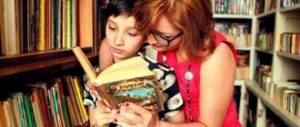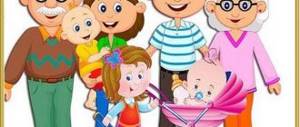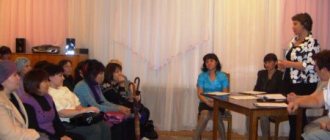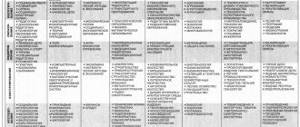Parent meeting in 3rd grade “How to raise a child’s love of reading”
All-Russian competition for teachers for the best methodological development “Parent meeting-presentation”
Parent meeting in 3rd grade.
Subject. How to raise a child's love of reading.
Target:
creating conditions for parents to understand the importance of family reading, forming a positive position regarding introducing their own child to reading.
Tasks:
• To acquaint parents with the requirements of the Federal State Educational Standard on technology and reading standards in elementary school.
•To promote a love of reading in younger schoolchildren.
Progress of the parent meeting.
Teacher's opening speech.
Today we have gathered to discuss an important issue. How to help children fall in love with books and reading. (slide 1)
Statistics analysis.
Statistics show that today's children read too little. Indeed, the reading crisis around the world has reached alarming proportions, and our country (once the most reading country in the world), unfortunately, is no exception. Today, not only children themselves, but also adults often ask the question: “Isn’t reading outdated?” Is the need for reading really so urgent today, in the age of high technology, when there are so many alternative ways of obtaining information? (parents' answers).
In fact, today people need reading even more than a hundred years ago, and no other information technology can replace it.
Introducing parents to the requirements of the Federal State Educational Standard on technology and reading standards in elementary school.
The purpose of reading lessons in elementary school is “to master the skill of conscious, correct, fluent and expressive reading, as basic in the education system of primary schoolchildren, to form a reading horizon and gain experience in independent reading activity, to improve all types of reading activity, including reading competence.
Reading competence is not running your eyes along the lines, but a constantly developing body of knowledge, skills and abilities, that is, a quality of a person that improves throughout his life.
The formation of reading competence is implemented in the following areas: (slide 2)
1. Formation of reading skills: the ability to read aloud and silently, mastery of the main types of reading (introductory, in-depth, search, viewing).
2. Well-read. This competence includes the following components: knowledge of the studied works, an understanding of literary concepts, their use and understanding; knowledge of books and works from the children's reading range offered in educational textbooks for each grade
3. Ability to work with a book (identifying and selecting books by genre, author, topic, etc.); knowledge of the elements of the book.
4. Skills and abilities of reading activity itself, ensuring the perception, interpretation (interpretation) and evaluation of a work of art as the art of words, that is, according to the laws of this art (at a level accessible to schoolchildren of each year of study). This competence is based on versatile work with text.
The task of parents in elementary school is to help develop reading skills.
What is meant by reading technique? (slide 3)
Reading is a complex psychophysiological process in which two aspects can be distinguished:
1) semantic – understanding, awareness of the content and meaning of the text being read
2) technical (subordinate to the semantic one, serving it) - speed (tempo), correctness and expressiveness of reading. Reading meaning
assumes the reader's understanding:
•the meanings of most of the words used in the text, both literally and figuratively;
•the content of each of the sentences included in the text, understanding the semantic connection between sentences;
•the content of individual parts of the text (paragraphs, episodes, chapters) and the meaning of these parts (i.e. not only what is said, but also what is said);
•the main meaning of the entire content of the text, i.e. awareness of this content and your attitude to what you read.
Correct reading -
is expressed in the fact that the reader avoids mistakes, or, on the contrary, makes: substitutions, omissions, rearrangements, additions, distortions, repetitions of letters (sounds), syllables and words; correctly or incorrectly emphasizes words in the text being read.
Reading speed (tempo) (slide4)
characterized by the number of words spoken per minute
.
Reading speed indicators in primary grades
| 1 class | 2nd grade | 3rd grade | 4th grade | |
| Incoming control | 30 – 40 words | 50 – 60 words | 70 – 80 words | |
| I half of the year | 25 – 30 words | 40 – 50 words | 60 – 70 words | 80 – 90 words |
| II half of the year | 30 – 40 words | 50 – 60 words | 70 – 80 words | 90 – 110 words |
State educational standards indicate the following components of reading technique at the time of completion of primary education : (slide 5)
reading method - reading in whole words;
correct reading - reading an unfamiliar text in compliance with the norms of literary pronunciation;
reading speed - setting a fluency rate that is normal for the reader, allowing him to comprehend the text;
setting to gradually increase reading speed.
Such reading requirements are imposed by the Federal State Educational Standard.
Analysis of questionnaires and students' reading techniques.
How are things going with children’s reading during and after lessons?
(The teacher introduces students to reading techniques. Each parent receives a card “Monitoring reading technique” of their child. (Appendix 1)
Parents have the opportunity to compare the results with the table «
Indicators of reading speed in primary grades.")
A survey was conducted in class. The students were given a questionnaire.
Questionnaire for students.
Do you think a person can live without books?
What do you like to do most: read, play, watch TV?
What books do you like to read: poems, fairy tales, about animals?
What do you like to receive as a gift: a book, games, clothes?
Do you have a lot of books at home?
(slides 6,7 introduce the results of the survey
) (Discussion)
Many articles have been written about the importance of reading; many teachers and writers talk about children much less likely to have problems with literacy, both in oral and written speech.
5.Teacher's story
about the importance of family reading.
In her book on how to properly teach your child at home, Cecile Lupan writes the following: “Instilling in a child a taste for reading is the best gift we can give for him.” (slide
(slide
How to instill interest and love for reading and books? (discussion)
Firstly, this is joint reading.
It is necessary to read fairy tales to your child from a very early age. But you shouldn’t think that reading aloud is necessary only until the child learns to read on his own. Reading together in a family is a fascinating activity that brings all its members unusually closer together. Reading to a child is not just the responsibility of parents, it is a unique way of communication that has practically no substitute.
The teacher conducts a survey of parents.
Questionnaire for parents . (slide 9)
1. Does your child like to read books?
2.How much time does he spend reading a book?
3.Do you force your child to read or does he do it without coercion?
4. How do you encourage this?
5. Do you discuss what you read with your child?
6. Do you consider yourself an avid reader?
Five tips for parents. (slides 10-14)
Family reading helps to instill in a child a love of reading without coercion. Never punish misbehavior by reading. This is a gross error of education and the best way to disgust a book.
Reading and discussing a book together strengthens family bonds. Read for yourself. If a child has never seen mom and dad with a book in their hands, then where will his love of reading come from?
Reading a book aloud to the whole family by your child improves his reading technique and speed. Read alternately, partly by an adult, partly by a child.
A child can ask an adult about misunderstood places in the book and ask questions about what they read. This increases the authority of the parents in the child. For the first readings, take only suitable books - bright, with large print, with many pictures and a plot that is interesting to follow.
Family reading allows an adult to participate in the child’s life and explore the world of his interests. Arrange an exhibition of drawings based on the books you read. Encourage your child to visit the library, go with him. Make sure that your reading is systematic - every day for 15-20 minutes.
You can start a reading diary in which the most interesting works will be recorded.
Secondly, it is the right choice of book to read. (Slide 15)
How to choose a book to read? The best literature for children is the one that teaches them imagination, creative thinking, and the ability to see different paths and possibilities. In addition, the book is a powerful source of morality and ethics. Fairy tales, myths, and proverbs touch on the most important issues: relationships in society, power, duty, obedience, moral choice in a difficult situation. What is a good children's book? A good book is, of course, an entertaining plot that includes overcoming difficulties, adventures, and - after so much excitement! - a happy ending that brings a sigh of relief from the child. A good book also includes characters who become good friends for children while reading.
Exchange of views of parents on the development of reading interest and reading skills in the family.
Parents share their experiences in developing interest and love for reading.
Results of the parent meeting.
Parent meeting decision:
To promote a love of reading in younger schoolchildren.
Develop your child's reading interest.
Annex 1
Reading technique monitoring
| Start 2017-18 | First half of 2017-18 | Second semester 2017-18 | Start 2018-19 | First half of 2018-19 | Second half of 2018-19 |
| Reading pace | |||||
| Reading method | |||||
| Right | |||||
| Mindfulness | |||||
| Expressiveness | |||||
| Mark |
Reading technique development map
| Number of words |
| 250 |
| 240 |
| 230 |
| 220 |
| 210 |
| 200 |
| 190 |
| 180 |
| 170 |
| 160 |
| 150 |
| 140 |
| 130 |
| 120 |
| 110 |
| 100 |
| 90 |
| 80 |
| 70 |
| 60 |
| 50 |
| 40 |
| 30 |
| 20 |
| 10 |
| 0 |
Teacher: Lvova S. A. “How to raise a child’s love of reading” PPTX / 3.23 Mb
Parent meeting 3rd grade
Parent meeting in 3rd "B" grade
Date: 10/22/2015
Time: 18 hours Purpose:
to acquaint parents with the curriculum for the 2020-2020 school year (About the vacation dates for the 2015-2016 school year).
Tasks:
•Develop a system of cooperation with the family in the interests of the child;
•Organize assistance in the education, physical and spiritual development of the child; •Stimulating their desire to become good parents. Class Chairman: Koftunova I.V. Class Secretary: Kozulina A.N. Present: 10 people. Agenda:
1. About the curriculum for the 2020-2020 school year (About the dates of vacation for the 2015-2016 school year) (message from the class teacher Lonshakova E. G.) 2. About the organization of hot meals at school (message from the class teacher Lonshakova E. G.)
3. Fulfillment of the requirements of the school Charter: behavior, appearance, absences, tardiness (message from the class teacher E. G. Lonshakova)
4. Prevention and safety (fire safety, accident prevention, anti-terrorist safety (message from the class teacher
Lonshakova E. G.).
5.About the school website, about the electronic magazine 1.Listen to:
Class teacher: Lonshakov E.G. - Good evening, dear parents!
I'm glad to see you all! — School hours: school lessons begin at 8:30 am. Children must arrive at school no later than 8:20 am. Mobile phones in lessons should be on vibrate alert, please remind them of this. — Subjects in the new school year: the number of academic subjects in grade 3 remains unchanged: Russian language - 5 hours per week, mathematics - 4 hours per week, literary reading - 3 hours per week, the world around us - 2 hours per week, technology - 2 hour, physical education - 3 hours per week, foreign language - 2 hours per week, music - 1 hour per week, fine arts - 1 hour per week. Students must attend all of the listed courses. The child must take the diary with him to school and submit it upon the teacher’s first request. — About the vacation dates for the 2015-2016 academic year Vacation schedule for the 2015-2016 academic year Decided:
To comply with the school’s operating hours (responsible: parents of students, term: constantly).
2. Listened to:
Class teacher: E. G. Lonshakova, - At school, the children receive hot meals after the second lesson.
Resolved:
To take this information into account.
3. Listened to:
Class teacher E. G. Lonshakova - The behavior of students in the classroom must comply with certain standards.
Pay attention to the entries in the diaries. I try to write down all the information about the life of the school and your child’s behavior. - Missing classes. The parent is obliged from 8.00 to 8.30 to inform the class teacher of the reason for the child’s absence from school on a given day. — Dress code (business style) On the day of physical education - sportswear, sneakers. — Parents can only visit teachers outside of school hours. Resolved:
To take into account the requirements for the implementation of the school’s Charter and the rules of conduct for students.
Responsibly fulfill the requirements of the school and form responsible relationships among children. Be sure to have a preventive conversation with the children at home. 4. Listened to:
Class teacher Lonshakova E.G. Fire safety, accident prevention, anti-terrorist safety, formation of a healthy lifestyle.
Decided:
to follow the recommendations of the class teacher.
5. Listened to:



